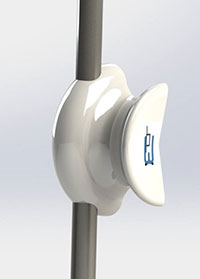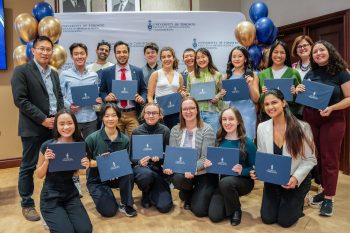Bending down more than a hundred times a day to wring out a mop is back-breaking work for caretakers around the world. But if Jeremy Wang, Shuyi Wu, Ryan Williams and Noah Yang (all EngSci 1T7 + PEY) have their way, mopping is about to get a whole lot easier.
The third-year Engineering Science students won second prize in the 2016 Minerva Canada James Ham Safe Design Awards competition today for designing a deceptively simple device called PowerWring that could save thousands of workers from back strains and sprains.
“It’s already an achievement to have the blessing of University professors and caretaking staff, but getting the thumbs-up from an organization whose very focus is on workplace safety and safe design is extremely valuable to us,” says Wang.
Mops are usually wrung out using the familiar mop-wringer mounted on top of a bucket. The process requires a worker to bend over and apply about 15 pounds of force by pushing down on a short, low handle with one hand.

The PowerWring team’s ingenious innovation is to mount a small, simple device on the wringer handle that allows the worker to use the much longer mop handle to do this job instead. The worker can stay upright while wringing the mop, and the force required of them is reduced by half or more. Most existing wringers can be retrofitted with the device, which is easy to produce and inexpensive.
The design originated when the team was enrolled in Praxis Engineering Design, a first year Engineering Science course taught by Professors Jason Foster (EngSci) and Robert Irish (ECP, EngSci). “The course challenges students to improve the lived experience of some group in the broader community,” says Irish. “The PowerWring design offers a simple and elegant solution to a common problem for people whose work is often ignored.”
In 2014, PowerWring was selected for further development by the Faculty’s Entrepreneurship Hatchery, who supported patent applications and market research. The team has patents under review in Canada and the U.S., and has been working closely with U of T Facilities and Services while testing and refining the design.

“Feedback from caretakers has been very positive and invaluable in helping us to refine the design. We’ve received great support from U of T Caretaking and, with their help, we plan to roll out the device to all caretakers across campus within a year,” says Wang. “It feels amazing to see something we have designed have a real impact on workers’ lives, especially in an area that is traditionally neglected and dominated by the momentum of tried-and-true gadgets even if they aren’t all that great.”
“Our Awards Committee was very impressed with the team’s simple and very cost effective design of PowerWring for preventing lower back and repetitive stress injuries in the janitorial industry,” says Tony Pasteris, President of Minerva Canada Safety Management Education Inc. “We were also impressed with the team’s entrepreneurial spirit in applying for Canadian and U.S. patents for their design.”
The team received the award today at the WSPS Partners in Prevention Conference in Mississauga, along with a plaque and $1,500.
The Minerva Canada James Ham Safe Design competition challenges engineering undergraduate students from across Canada to make an original contribution toward integrating safety into engineering design. Students are asked to suggest ways to improve the existing design of devices, processes or systems, envision new, innovative designs that will eliminate or reduce potential hazards, and create tools to help manufacturers and workplaces integrate safety into new or retrofit designs.
The award is named in honour of James Milton Ham whose Royal Commission Report on Health and Safety led to the creation of Ontario’s Occupational Health and Safety Act in 1979 and to the adoption of the Internal Responsibility System in Ontario workplaces. Professor Ham is the former head of Electrical Engineering (1964-66), dean of the Faculty of Applied Science & Engineering (1966-1973) and president of the University of Toronto (1978-83).
This is the fourth year in a row that U of T Engineering students have received one of the top two Minerva prizes.



